Snake plants, also known as Dracaena trifasciata, are well-regarded for their hardiness and ease of growth, making them a perfect choice for indoor gardening. Despite their robust nature, snake plants can occasionally encounter issues that can affect their health and appearance.
In this comprehensive guide, we’ll delve into 11 common snake plant problems and offer simple and effective solutions to address these issues.
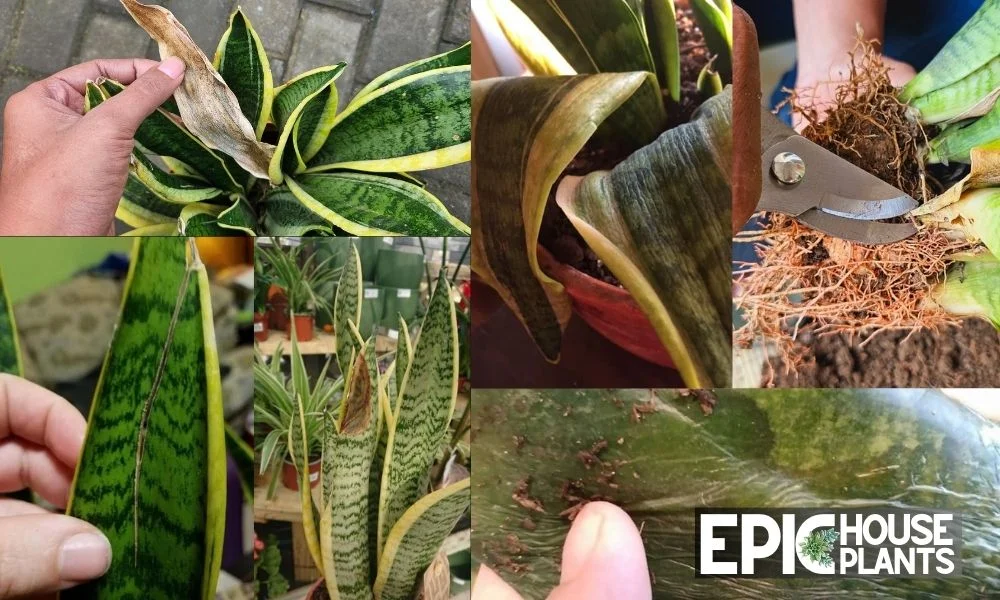
Summary Table
| Problem | Solution |
|---|---|
| Yellow Leaves | Check for overwatering, ensure adequate sunlight, and consider repotting. |
| Brown Tips | Increase humidity levels, use filtered water, and consider temperature control. |
| Curling Leaves | Avoid overwatering and maintain moderate humidity levels. |
| Wrinkled Leaves | Ensure proper watering routine and check for root rot. |
| Leaves Falling Over | Check for overwatering and ensure proper support structure. |
| Fungus Gnats | Allow the soil to dry out completely between watering, and use a natural insecticide. |
| Leaves Splitting | Balance soil pH, provide gradual environmental changes, and consider using a humidifier. |
| Deformed or Misshapen Leaves | Control pests with methods such as applying neem oil. |
| Stunted Growth | Replenish soil nutrients through repotting and ensure the plant has adequate sunlight. |
| Snake Plant Isn’t Growing | Address root issues by removing damaged roots and repotting with well-draining soil. |
| Brown and Mushy Roots | Avoid overwatering, cut off rotten roots, apply hydrogen peroxide for sterilization, and repot in fresh soil. |
Problem 1: Yellow Leaves
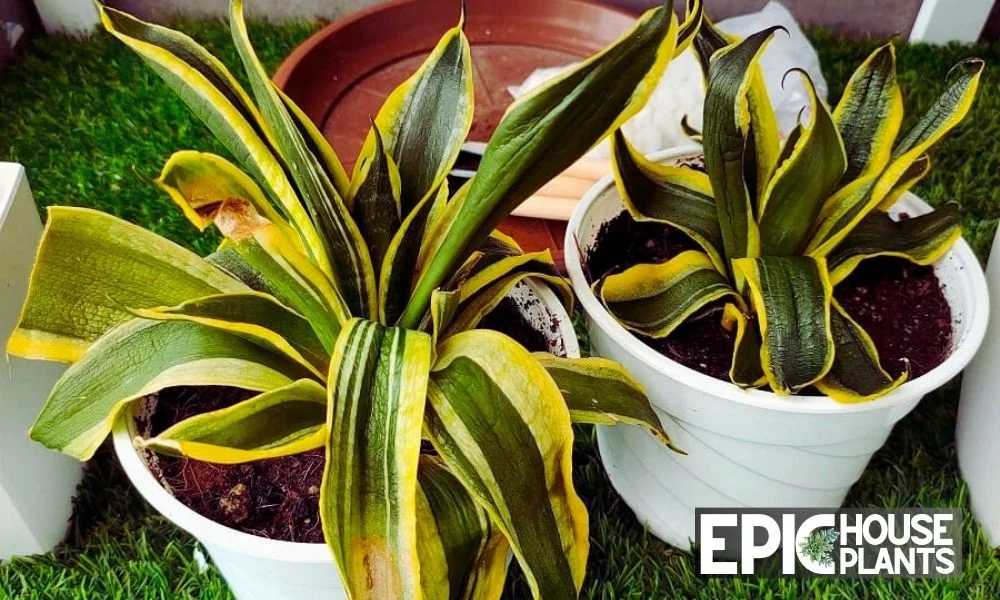
One of the common issues you might encounter with your snake plant is yellowing leaves. This symptom could be due to several factors:
Causes for Yellow Leaves
- Overwatering: Snake plants prefer dry soil conditions. Overwatering could damage the roots, inhibiting them from absorbing essential nutrients from the soil. Consequently, the leaves may not receive enough nutrients, causing them to turn yellow.
- Pest Infestation: Pests, like spider mites and mealybugs, could harm the snake plant by sucking the sap from the leaves. This deprives the plant of its vital nutrients and results in yellow leaves.
- Excessive Sunlight Exposure: If the snake plant is exposed to strong, direct sunlight, the cell of the leaves might get damaged, leading to a yellow appearance.
Prevention and Remedies for Yellow Leaves
- Appropriate Watering: Wait until the soil is completely dry before watering your snake plant. This approach prevents overwatering and the consequent damage to the roots.
- Pest Control: Regularly inspect your snake plant for pests such as spider mites and mealybugs. Apply pesticide at the first sign of infestation to protect the plant’s health.
- Ideal Lighting: Place your snake plant in a spot with plenty of indirect light. This measure safeguards the plant from the adverse effects of strong, direct sunlight.
For a more detailed analysis of the causes and remedies for yellow leaves in snake plants, check out this blog post on Reasons Why Your Snake Plant Leaves Turn Yellow.
Problem 2: Soft and Mushy Leaves
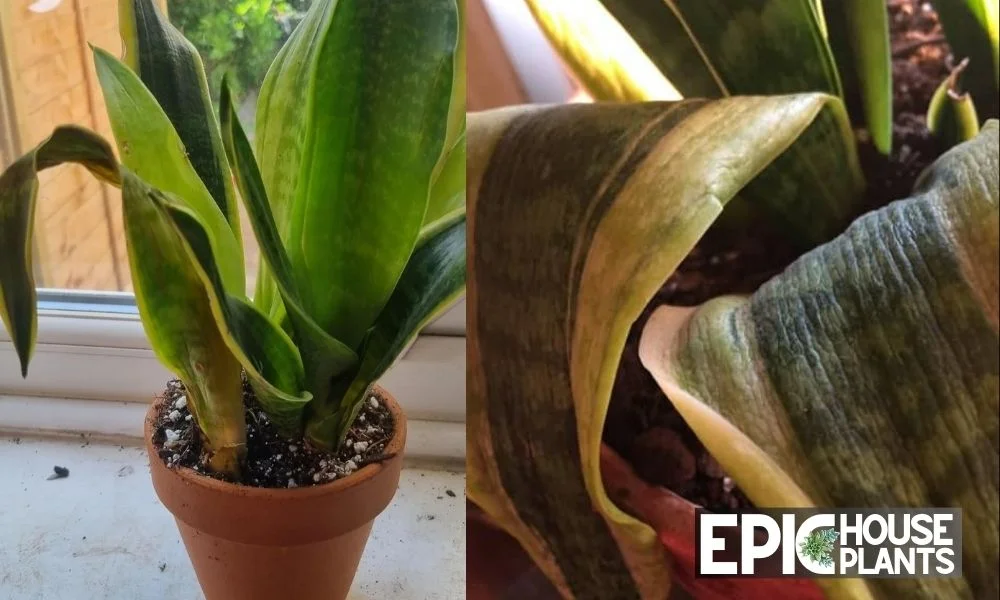
Another issue that can affect the health of your snake plant is the presence of soft and mushy leaves. Several factors can contribute to this problem:
Causes for Soft and Mushy Leaves
- Root Rot: Root rot, often caused by overwatering, can severely damage your snake plant. Healthy plants start from the roots. If the roots are damaged, the absorption of nutrients is inhibited, causing the leaves to become mushy.
- High Humidity: Snake plants can be prone to fungal attacks in high humidity environments. In such conditions, the leaves can quickly turn mushy.
- Cold Temperature Exposure: Cold temperatures can damage the cells of the leaves. Following exposure to cold temperatures, the leaves may turn mushy within a couple of days.
Prevention and Remedies for Soft and Mushy Leaves
- Proper Watering: Just as with the problem of yellow leaves, proper watering can prevent root rot. Wait until the soil is completely dry before watering your snake plant. If root rot has already occurred, consider repotting your snake plant and removing the rotten roots.
- Appropriate Placement: Place your snake plant in a well-ventilated area with good air circulation. This measure can help control humidity and prevent fungal attacks.
- Indoor Placement in Colder Months: Keep your snake plant indoors during colder months to protect it from cold temperature damage.
To learn more about the causes and prevention of mushy leaves in snake plants, read this helpful post on snake plant mushy leaves.
Problem 3: Brown Spots or Tips on Leaves
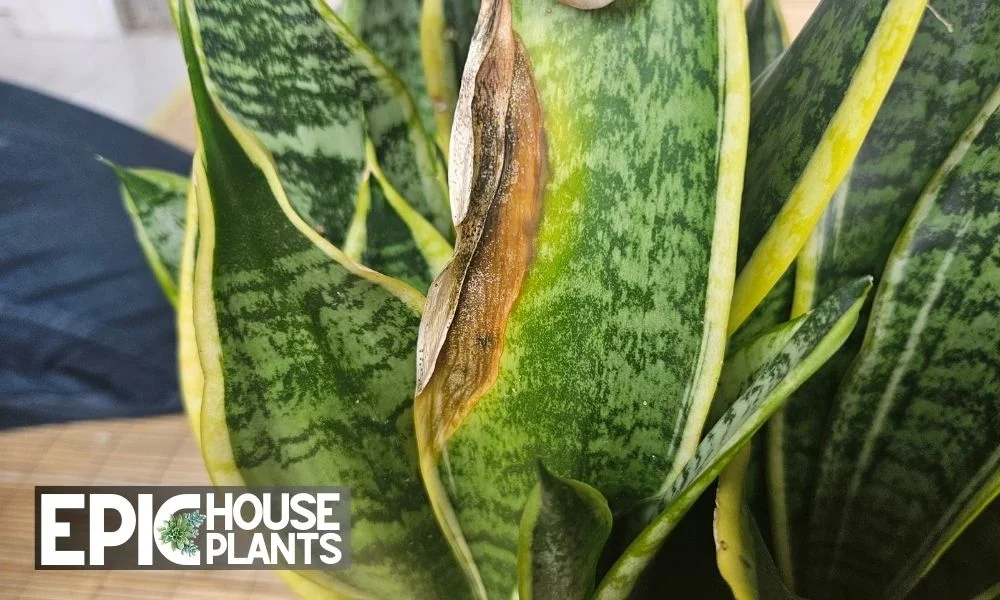
Snake plants with brown spots or tips on their leaves can indicate a problem in your plant’s environment or care routine.
Causes for Brown Spots or Tips on Leaves
- Chlorinated Water: Tap water containing chlorine could prevent the roots from absorbing potassium, a vital nutrient for plants. The deficiency of potassium in the snake plant can lead to the development of brown spots on the leaves.
- Extreme Temperature Changes: Snake plants could experience stress when moved from indoors to outdoors suddenly, leading to the appearance of brown spots or tips on their leaves.
- Excessive Sunlight Exposure: Prolonged exposure to strong sunlight can damage the cells of the leaves, resulting in brown spots or tips.
Prevention and Remedies for Brown Spots or Tips on Leaves
- Use Spring Water or Filtered Water: To avoid chlorine’s negative impacts, consider using spring water or filtered water for watering your snake plant. Alternatively, you can let tap water sit out overnight allowing chlorine to evaporate before use.
- Gradual Transition: Avoid sudden changes in your snake plant’s living conditions as it may shock the plant. Instead, a gradual, progressive change is recommended.
- Shade Placement: Protect your snake plant by placing it in the shade to avoid direct sunlight exposure.
For a detailed guide on dealing with brown spots or tips on snake plant leaves, check out snake plant brown tips and how to fix them.
Problem 4: Curling and Wrinkled Leaves
Snake plants with curling or wrinkled leaves can indicate insufficient care or adverse environmental conditions.
Causes for Curling and Wrinkled Leaves
- Underwatering: If the potting soil goes completely dry for too long, the leaves may start curling. This curling or twisting is a survival mechanism of the snake plants to preserve their water reserves by restricting the respiratory process.
- Pest Infestation: Spider mites and mealybugs can suck the sap from the leaves, depriving the snake plant of nutrients and resulting in curling and wrinkling of the leaves.
- Excessive Sun Exposure: Too much sunlight can cause damage to the plant leaves, leading them to curl and wrinkle.
Prevention and Remedies for Curling and Wrinkled Leaves
- Proper Watering: If your plant has gone dry for too long, soak it thoroughly to restore its water levels.
- Pest Control: Applying neem oil can effectively kill pests and prevent further infestation.
- Shade Placement: Protect your outdoor snake plant from direct sunlight by placing it in a shaded area.
Problem 5: Drooping and Falling Leaves
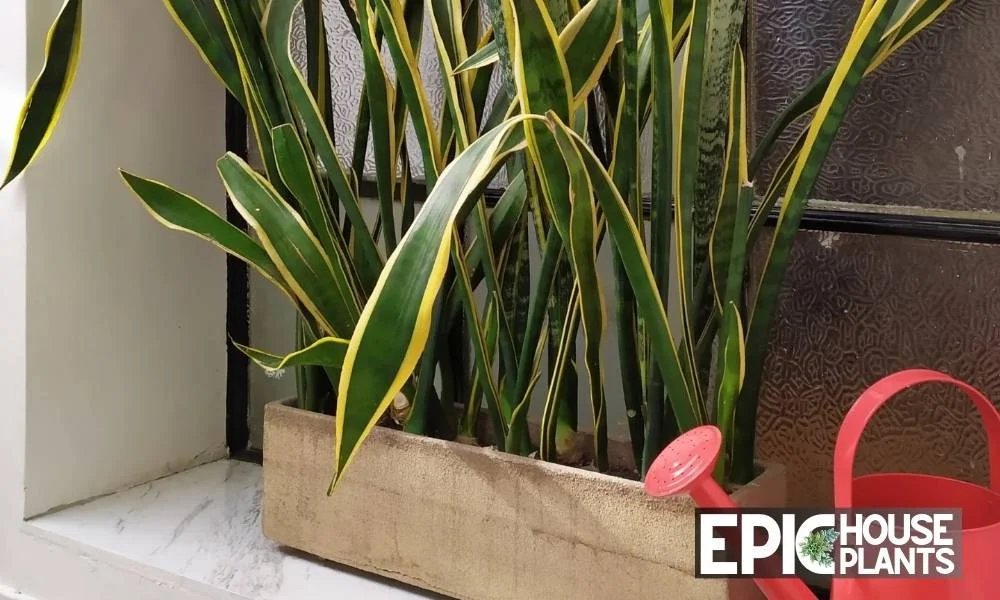
If your snake plant’s leaves are drooping or falling, this can be a sign of insufficient watering or inadequate light.
Causes for Drooping and Falling Leaves
- Underwatering: Prolonged underwatering can cause the plant cells in the leaves, which keep them strong and upright, to thin out. This results in the leaves falling over.
- Low Light: Excessive darkness for long periods can result in droopy snake plant leaves.
Prevention and Remedies for Drooping and Falling Leaves
- Proper Watering: Soak your plant thoroughly if it has gone dry for too long.
- Adequate Lighting: Move your snake plant to an area with plenty of indirect light.
For a detailed guide on dealing with snake plant drooping leaves, check out Reviving Your Drooping Snake Plant: A Step-by-Step Guide
Problem 6: Skinny and Stretched Leaves
Skinny and stretched leaves in a snake plant can be a symptom of nutrient deficiency or inadequate light.
Causes for Skinny and Stretched Leaves
- Lack of Nutrients: The snake plant needs nutrients to grow and flourish. Without sufficient nutrients, the plant cannot grow big and strong.
- Low Light: When snake plants don’t get enough light, they will begin to grow and stretch toward the nearest light source. The thin and narrow leaves will decrease the strength of the leaves.
Prevention and Remedies for Skinny and Stretched Leaves
- Repotting: Repot your snake plant when it becomes overcrowded. This can provide it with sufficient nutrients for growth.
- Adequate Lighting: Move your snake plant to an area with plenty of indirect light.
Problem 7: Leaves Splitting

Snake plant leaves splitting is another common issue faced by indoor gardeners. Understanding the causes and remedies is crucial for maintaining healthy plants.
Causes for Leaves Splitting
- Boron Deficiency: Boron plays a crucial role in sugar transportation to plants, influencing foliar development. A deficiency of this nutrient often results in split leaves or stunted growth as the plant cells fail to develop properly.
- Extreme Temperature Changes: Similar to the previous problems, sudden temperature changes when moving the snake plant from indoors to outdoors can cause plant stress, leading to leaf splitting.
- Low Humidity: Dry air or low humidity can dry out snake plant leaves, making them brittle and prone to splitting or cracking.
Prevention and Remedies for Leaves Splitting
- Soil pH Balance: Regularly check the pH of your soil. If it’s highly alkaline, add vinegar or lemon; for overly acidic soil, add lime to balance the pH.
- Gradual Environment Changes: If you need to move your snake plant, ensure to provide the necessary changes gradually to prevent plant stress.
- Humidifier: Invest in a quality humidifier to maintain the appropriate humidity level for your plants.
For further reading on why snake plant leaves split and what you can do about it, check out The Curious Case of the Snake Plant Leaves Splitting: What’s Happening and Why.
Problem 8: Deformed or Misshapen Leaves
Deformed or misshapen leaves can detract from the aesthetic appeal of your snake plant, but they can also be a sign of a more serious issue.
Causes for Deformed or Misshapen Leaves
- Pest Infestation: Common pests like spider mites, mealybugs, and thrips consume the plant’s internal fluids, leading to deformed or misshapen leaves if not promptly treated.
Prevention and Remedies for Deformed or Misshapen Leaves
- Pest Control: Applying neem oil can help control these pests and prevent further infestation.
Problem 9: Stunted Growth
Stunted growth in snake plants can be disheartening for plant lovers. Knowing the reasons and solutions can help you rectify this problem.
Causes for Stunted Growth
- Lack of Nutrients: Soil nutrient deficiency can inhibit plant growth. When a plant consumes all soil nutrients, the barren soil cannot support further growth.
- Poor Lighting: Snake plants need light to survive and thrive. Without sufficient light, the plant’s energy production through photosynthesis reduces, leading to stunted growth.
Prevention and Remedies for Stunted Growth
- Repotting: Repot your snake plant into a larger pot with fertile soil to replenish the absorbed nutrients.
- Adequate Lighting: Move your snake plant to a location with more sun exposure, but ensure it’s filtered and indirect.
Problem 10: Snake Plant Isn’t Growing
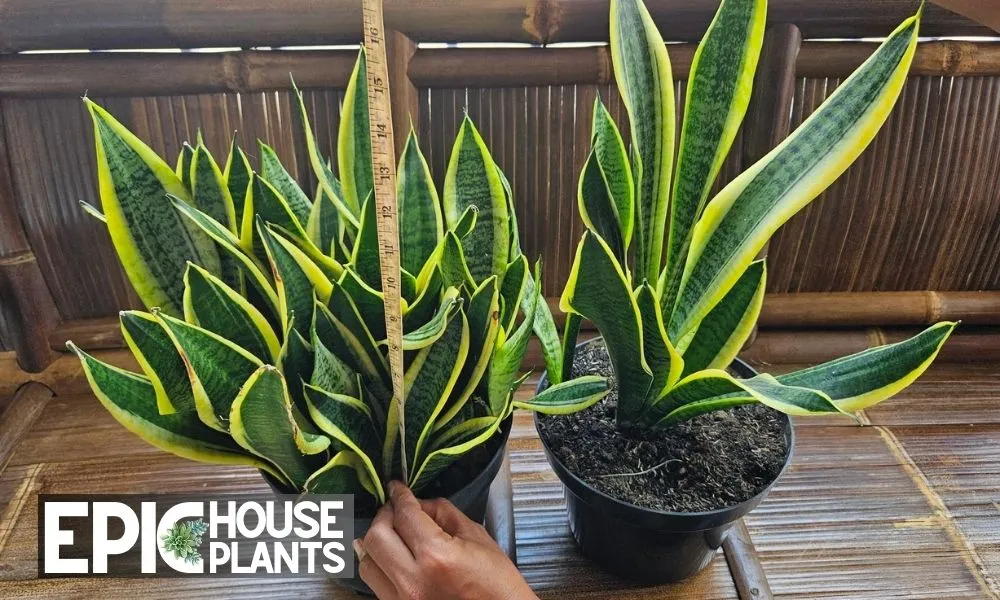
If your snake plant isn’t growing, it might be dealing with root problems. Let’s dive into the causes and remedies.
Causes for Snake Plant Not Growing
- Root Problems: Damaged roots cannot absorb nutrients from the soil, impeding plant growth. Root damage can occur due to fungal and bacterial infections, often starting from overwatering.
Prevention and Remedies for Snake Plant Not Growing
- Root Care: Cut off damaged roots and repot the snake plant using well-draining potting soil.
To know more about the growth of snake plants, visit How Fast Do Snake Plants Grow?.
Problem 11: Brown and Mushy Roots
Finally, brown and mushy roots are a clear sign of overwatering, leading to root rot. Here’s what you can do to prevent and treat this problem.
Causes for Brown and Mushy Roots
- Overwatering: Overwatering your snake plant causes waterlogged soil, which leads to root rot.
Prevention and Remedies for Brown and Mushy Roots
- Proper Watering: Allow the soil to dry completely between watering sessions.
- Root Treatment: If root rot has occurred, cut off the rotten parts and apply hydrogen peroxide to sterilize the roots from bacteria and fungi.
- Repotting: Repot the snake plant using fresh soil.
Final Words
In conclusion, caring for a snake plant involves a balance of appropriate watering, adequate lighting, pest control, and attention to potential issues such as root rot or nutrient deficiencies.
By understanding these common problems and their solutions, you can help ensure that your snake plant remains a healthy and vibrant addition to your indoor garden.
Author

Pudji Haryanto
Pudji Haryanto is a writer and urban farmer with a passion for cultivating plants. He has over 15 years of experience in agriculture and currently manages a 65,000 square foot rice-field and yard filled with various plants, including vegetables, spices, flowers, and garden plants.
